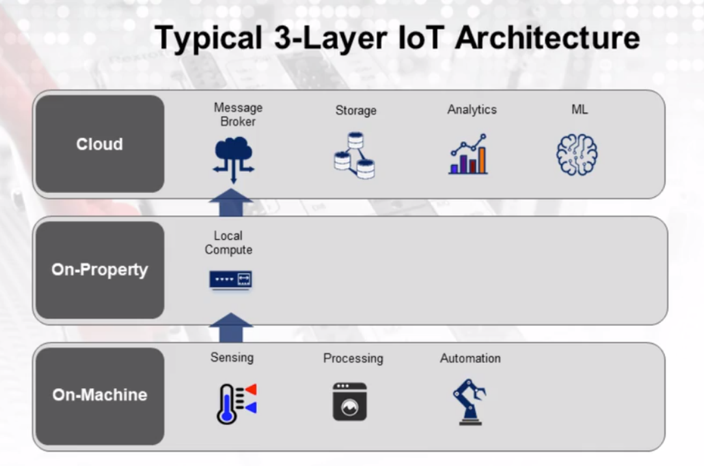As automation and IT join forces, operations driving industrial advancements must meet the special need for real-time control and data requirements of execution and enterprise systems. Even a quick look at a short list of things almost all industries will need to consider can be daunting. The unstoppable train that is technology has no plans of slowing down, so it’s critical to strategize on how best to enable them for your company. For companies moving many operations away from the data center and IT support, it’s necessary to understand the relationship between applications, computing and devices (the Edge Architecture) to design, build and maintain the best solution and empower operationally-simple performance and security.
In the typical 3-Layer IoT architecture, the bottom layer, or On-Machine layer, accommodates a mix of simple and complex sensors. These sensors collect data and sends it to a gateway system in the middle On-Property layer. The data is then processed and travels to the top layer in the Cloud to be stored and analyzed.
Here are examples of some opportunities and challenges found in four common application architectures.

Edge Architecture Use Case 1: Oil and Gas
On-Machine: At this layer the sensors are placed in a harsh environment. Sensors such as valves and pumps might be remote or out in the field, where they must run on battery and have limited connection to the outside world.
On-Property: On this layer there are often many legacy systems and equipment that will be, or has been “on premise” for extended periods of time. As a result, since it is unlikely that such equipment will need to be replaced, proper planning is important to define how new IoT systems will need to be retrofitted.
Cloud: At the top layer the focus is efficiency and safety. It’s vital to have visibility of the entire distribution system to keep the system at peak use.
Edge Architecture Use Case 2: Life Sciences
On-Machine: This is a clean-lab-condition with plenty of power available to the sensors. Depending on the location of environment, there could be a combination of off-the-shelf and custom-made sensors. Furthermore, it’s less likely that the sensors will be battery powered.
On-Property: At this layer it’s all about custom process control. It is critical that things are kept at exact temperatures, correct times and precise measurements.
Cloud: In the Cloud it is very similar to what’s happening at the gateway. There must be regulatory compliance and traceability of all the process controls. At this stage you’re less likely to have communication or power level difficulties like an oil and gas situation.
Edge Architecture Use Case 3: Utilities
On-Machine: In this harsh environment there is a mixture of new and old technology, from smart meters to highly fault-tolerant (occupancy) demand sensors intended to measure use and reduce waste.
On-Property: Here you’ll find newer technology, such as micro-grids or substation management tools. These help with load balancing and bringing in alternative generation options.
Cloud: Within a utility project the focus on improving efficiency for proper load balancing, lowering environmental impact, and checking entire health of a network continues at the cloud level.
Edge Architecture Use Case 4: Transportation
On-Machine: Because transportation includes century-old technology used by auto, rail, and air, sensors must be developed to pull information for each unique instance. This adds to the challenges in this often exceptionally large, harsh environment. These sensors could include cameras, smart roads, GPS, LIDAR and more. And, as with life science projects, transportation environments have plenty of power available to sensors.
On-Property: At this layer you’ll find the vehicles themselves, from cars and trucks to trains and airplanes. Unlike the first three use cases, at this level the unit (or vehicle) must remain fully capable of operation without connection to a Cloud.
Cloud: Within transportation, the Cloud handles asset tracking, weather and traffic monitoring, vehicle health, as well as preventative maintenance.
What Will Your Edge Architecture look like?
The various functions that can be carried out on-property will affect what’s needed in the Cloud, and each use case will have its own critical requirements. The way they conduct themselves turns into requirements for your IoT systems. The type of environment in which the sensor is stored can affect the type of pressure, processing and other measures you’ll need.
To understand how to determine the best edge computing architecture for your needs, watch our webinar IIoT & Edge Architectures based on Application – Use Cases & Lessons from the Field.
[sc name=”Edge_Computing_CTA_2″]